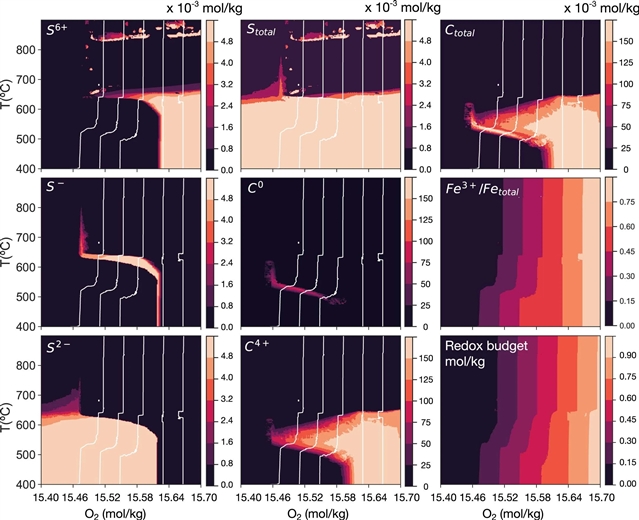
近日,西班牙安达卢西亚地球科学研究所教授Padrn-Navarta, Jos Alberto和 Lpez Snchez-Vizcano, Vicente的研究小组提出了沉积物流沙调节的沙漠化地幔楔氧化作用。相关论文于2023年3月2日发表在《自然—地球科学》杂志上。
研究团队证明了沉积物源流体的渗透可以调节并极大地改变沙漠化板块流体的氧化能力。沙漠化氧化能力的调节主要取决于氧化还原敏感元素(尤其是硫酸盐)的溶解氧化水基的稳定性和丰度,而不仅仅取决于沉积物的氧化状态。来自含石墨沉积物的含CH4流体的渗透降低了沙漠化流体固有的高氧化能力,解释了在天然变质橄榄岩中观察到的相对较低的fo2。现代俯冲带普遍存在含硫酸盐-CO2-的沉积衍生流体的渗透,在冷俯冲带和热俯冲带产生具有高氧化能力的沙漠化流体,导致全球地幔楔氧化速率为3.5 km3 yr-1。这种板状流体将以类似于弧-玄武岩生成的速率氧化地幔楔,从而解释了弧火山作用的氧化性质。
据了解,蛇纹岩在俯冲过程中高压脱水产生流体,使上覆地幔楔状物流动并熔化,形成原生岛弧玄武岩。这些玄武岩基本上比洋中脊的玄武岩氧化程度更高。在现今俯冲带的板块表面,这些沙漠化流体在本质被氧化,但由于俯冲蛇纹岩含硫量较低,导致地幔楔氧化速率较低,但这不能解释岛弧玄武岩的氧化源。
附:英文原文
Title: Mantle wedge oxidation from deserpentinization modulated by sediment-derived fluids
Author: Padrn-Navarta, Jos Alberto, Lpez Snchez-Vizcano, Vicente, Menzel, Manuel D., Gmez-Pugnaire, Mara Teresa, Garrido, Carlos J.
Issue&Volume: 2023-03-02
Abstract: High-pressure dehydration of serpentinite during subduction generates fluids that flux and melt the overlying mantle wedge, forming primary arc basalts. These basalts are substantially more oxidized than their mid-ocean ridge counterparts. At the slab surface of current subduction zones, these deserpentinization fluids are intrinsically oxidized, but, owing to the low sulfur content of subducted serpentinite, they only result in a low mantle wedge oxidation rate, which cannot account for the oxidized source of arc basalts. Here we show that infiltration of sediment-derived fluids modulates and can drastically change the oxidation capacity of deserpentinization slab fluids. The modulation of the deserpentinization oxidation capacity mostly depends on the stability and abundance of dissolved oxidized aqueous species of redox-sensitive elements—notably sulfate—and not solely on the oxidation state of the sediment. Infiltration of CH4-bearing fluids derived from graphite-bearing sediment reduces the intrinsically high oxidant capacity of deserpentinization fluids, explaining the relatively low fo2 observed in natural metaperidotite. Infiltration of sulfate-CO2-bearing, sediment-derived fluids—prevalent in modern subduction zones—generates deserpentinization fluids with a high oxidation capacity in cold and hot subduction zones, resulting in a global mantle wedge oxidation rate of 3.5 km3yr-1. Such slab fluids will oxidize the mantle wedge at a rate similar to that of arc-basalt generation and thus account for the oxidized nature of arc volcanism.
DOI: 10.1038/s41561-023-01127-0
Source: https://www.nature.com/articles/s41561-023-01127-0
